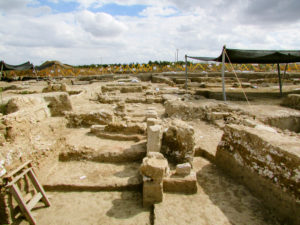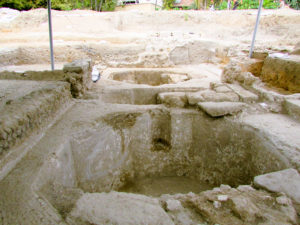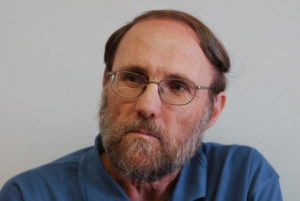Salvage Excavation in Israel
BAR Interviews IAA’s Head Archaeologist, Gideon Avni
Nathan Steinmeyer May 27, 2022 0 Comments 330 views
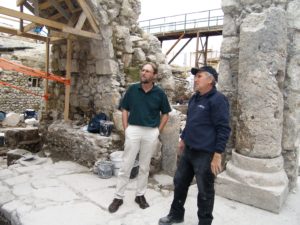

Gideon Avni overseeing excavations at the Western Wall in Jerusalem. Courtesy Gideon Avni and the Israel Antiquities Authority.
Gideon Avni, who heads the Archaeological Division of the Israel Antiquities Authority (IAA), began his archaeology career in 1980. Since then, he has conducted extensive archaeological fieldwork throughout Israel. Biblical Archaeology Review assistant editor Nathan Steinmeyer recently sat down with Avni to discuss the growing importance of salvage excavation in Israel. The conversation has been edited and modified for clarity and readability.
Become a Member of Biblical Archaeology Society Now and Get More Than Half Off the Regular Price of the All-Access Pass!
Explore the world’s most intriguing Biblical scholarship
Dig into more than 9,000 articles in the Biblical Archaeology Society’s vast library plus much more with an All-Access pass.
What is a salvage excavation and why is this type of archaeology important?
AVNI: It is a practice that goes on in many countries all over the world. The reason behind it is that in places like the southern Levant—Israel, Jordan, Palestine, Lebanon, and Syria—you have one of the densest concentrations of archaeological sites and, at the same time, these are very rapidly developing modern countries. Immediately, you face this contradiction: When you build new cities, there’s no other way to move forward except to excavate or destroy ancient sites. Just to give you the numbers, from the Negev in the south to the Galilee in the north, we have about 35,000 archaeological sites across 4,000 square miles, which makes it one of the densest concentrations of sites per area in the world. At the same time, this area of the country increased its population from 800,000 in 1948 to more than 9 million now, which makes it almost impossible to avoid destroying cultural heritage as the country grows.
This is the basis for the legal structure in Israel that enables the safekeeping of antiquities. If you have antiquities on your property—whether you own a house or you are a municipality or the government—any discovered sites and artifacts are owned by the State of Israel, through the IAA, which is the governmental agency that has a duty to protect antiquities. The director of the IAA has the right to decide what to do with the antiquities that are within your property. It may start by the IAA saying “don’t touch, you’re not allowed to do anything.” Or we may inspect the area and if we decide to carry out a rescue excavation and nothing particularly exceptional is discovered, after the proper excavation and documentation, you can go on with your development.
Just recently, there was the Yavneh excavation, which was triggered by the need to expand the town of Yavneh, which is south of Tel Aviv. There were going to be 20,000 new housing units on the fringe of Tel Yavneh, one of the region’s well-known ancient sites. After we started probing, we realized the area included a number of archaeological sites: an industrial area, burial grounds, and even some parts of the ancient tell. Since then, we’ve been excavating constantly and it will take another year, with 400 workers a day, 25 archaeologists, and so on. Now, if you look at the whole volume of Israeli archaeology, just in numbers, we have about 300 rescue excavations per year. Then there are around 50 organized and prescheduled excavations led by academic institutions.
This extensive rate of rescue excavation started more or less in 1990 when the IAA was established. Before that, the enforcement of the law on antiquities was not so strict. There is also the “polluter pays” principle, which applies in Israel and not in other countries. It means that if you own land that is to be developed and there is a need to conduct an excavation, you (as the landowner or developer) or the state (if the property is government owned) has to fully finance all aspects of the excavation, not only fieldwork, but also processing, storage, and publication. So, we’re speaking about half a billion shekels (around US $146 million) per year, which is being invested in rescue archaeology. That is huge! This is why the IAA has been growing to be the largest professional institution in the country. We have 300 archaeologists working today, which is not only more than any other university but also more than all the universities combined.
The basic idea is that cultural heritage must be protected. In Israel, we speak about the large sites, which are on what we call the 1000 Sites list, which are the country’s major sites, like Tel Megiddo, Hazor, or Caesarea, where no one would think of building something. But then we have the medium-sized sites or sites newly discovered through development, like Yavneh or Moza. So there are some major surprises.
Salvage excavations have also produced a new level of scientific approach to the archaeology of Israel. This is mainly because rescue excavations require that you excavate everything rather than just investigating specific periods. This is why the Islamic and the Mamluk periods, which were completely ignored in previous scholarship, are now becoming one of the frontlines of research. Dating systems are becoming much more refined and the whole attitude towards these periods is changing. Similarly for the prehistoric periods. We have quite a few underground Chalcolithic sites that have been discovered. There is a new understanding of the Neolithic (8500-4300 B.C.E.) and Early Bronze Age (3300-2300 B.C.E.), because of excavations at Issawiya, Yiftahel, and other sites in the north. It is not like doing contract archaeology, as you do in other countries. It is doing research.
Part of this lies in the fact that we do not allow salvage archaeology by private companies, as in the U.S. and many countries in Europe. Excavation must be done under the umbrella of a recognized academic institution. Of the four or five universities in Israel, some of them now have their own contract archaeology units, but they are very much embedded within the academic structure.
Everything that is excavated goes to our headquarters in Jerusalem. So, if you’re researching Neolithic arrowheads, the only place you can go to get everything that is available is the IAA headquarters. In many other countries, you have to wander around between regional museums and local agencies. In Israel, we have one centralized system.
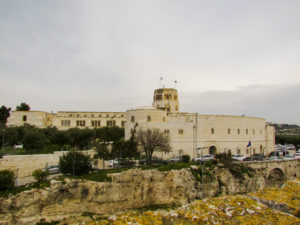

The Rockefeller Archaeological Museum in Jerusalem, headquarters of the Israel Antiquities Authority. Courtesy Nathan Steinmeyer.
How do you decide how large a salvage excavation will be?
AVNI: The first consideration is the volume and size of the development. The other issue is whether a site is going to be covered or quarried. When you build in Jerusalem, for example, and you need to have a basement for parking, you quarry 160 feet into the bedrock. But when you build a highway, sometimes you just cover the upper strata of a site. The IAA’s policy is not to excavate things that are not going to be destroyed. In addition, when a development is going to cover a very large area, we will do experimental excavation probes, which make up only about five to ten percent of the total area. The philosophy behind this is that we excavate too much. We cannot publish everything, and we need to keep something for future generations.
When something worthwhile is discovered, however, we often have to rethink the whole issue. Like in Yavneh, [because of the archaeology] they are going to change the development plan. They will cancel about 1,000 housing units and are discussing how to make the discovery a kind of public park. If something is preserved, there is also the issue of who is going to maintain the site. It is very nice to keep something but you need funding for maintenance. Other times, only a section of a site can be preserved.
What determines whether a site is preserved?
AVNI: There are the UNESCO (United Nations Educational, Scientific, and Cultural Organization) criteria for sites on their World Heritage List, and we adopted their criteria. They consider six principles, including the find’s rarity, its value to local society, its value to global society, and so on. Sometimes when you discover a religious building, either a synagogue, a church or a mosque, then other considerations come into play. Sometimes the local community insists on keeping it. Archaeologically, there may be no reason to keep such a place but because of religious issues, it is preserved. There are all kinds of considerations.
How long does a typical salvage excavation last?
AVNI: From a couple of days to two or three years. It’s very diverse. The majority are very short, usually three weeks. But then you have huge ones, and sometimes you have small projects that end in a couple of days.
Which Israeli universities have their own salvage archaeology programs?
AVNI: There are three of them. Hebrew University, Tel Aviv University, and now the University of Haifa. Bar-Ilan is also thinking about developing one because it is a growing market. This is the only field in humanities that produces income. So, there is pressure from the university on the archaeological institutes to establish such commercial academic programs. Sometimes the archaeologists are not in favor because they want to conduct their own research. They are not interested in going to excavate some obscure Byzantine ruin. It is an interesting game within the university, but it is a growing field.


What are the big differences between a rescue excavation and a university expedition?
AVNI: In a university expedition, you can design your research priorities. In rescue archaeology, you have to excavate everything. It also depends on the volume and size and importance of the rescue site. Sometimes, like at Moza, Yavneh, and Issawiya, a lot of resources may go to support research in the archaeological sciences. In a smaller excavation, you don’t have the resources and sometimes the area is very small. So the priority is basic documentation, where publication must be faster compared to research excavation. Also the rights related to excavation are very different. In a research excavation, an archaeologist can get approval for a 10-year project at a big tell site to study much larger research questions. You cannot do this in rescue archaeology. You get the rights only to the very specific area being excavated.
What do you find most satisfying about salvage excavation?
AVNI: Overall, savage excavation is much easier. You do not have to look for funding and instead can focus on getting everything ready to dig, all the administration, the workers, and the paperwork. You are doing 100 percent archaeology. In a university, you have to write grants and fight for students. Also, in salvage archaeology, you are involved in hundreds of sites, which are relevant to whatever you are doing, and you have the artifacts and the reports. So, unlike many other places, the volume of data creates very large opportunities for research on any given period, type of artifact, feature, or industry.
Are there ever not enough resources to do all of the excavations that are needed?
AVNI: It has happened twice. First, in the early 1990s, when two million people came into the country and they were housed in caravan sites. The state then decided to start the new construction of cities. That was the big boom in Israeli archaeology. Suddenly, you needed about 1,000 archaeologists, which we did not have. The second was about six years ago, when three huge projects came together at the same time, Beth Shemesh, Moza, and Issawiya. We did not have a solution for this. We were even speaking about bringing archaeologists from Eastern Europe and workers from China. We are working with Palestinians; this is one of the sources where Palestinian workers can come to Israel and work. But it is a problem in the fieldwork stage. You can bring 1,000 workers, but you need 200 archaeologists to direct them. The most serious problem was in the publication stage. Once you finish two years of excavation, you need another four years in the lab. And this is exactly the stage we are in now. There is a lack of archaeologists. Very few people are coming up to study archaeology, although from this is maybe the only field in the humanities in which once you finish your degree, you can secure a permanent position.


What are some of the challenges posed by salvage excavation?
AVNI: Salvage excavation is a kind of business management, but it is also an academic activity. We are struggling with the potential to produce first-class research out of our excavations but also the constant need to conduct more fieldwork. It is a very delicate balance. As the pressure grows to conduct more fieldwork, you often have to take people from the labs and send them to the field. This is the major challenge. And then there is the issue of opening the market for contract archaeology and how to control the market, in order to not lose control. We are very much trying to avoid this situation.
Read more in Bible History Daily:
All-Access members, read more in the BAS Library:
Queen Helena’s Jerusalem Palace—In a Parking Lot?
Not a BAS Library or All-Access Member yet? Join today.


